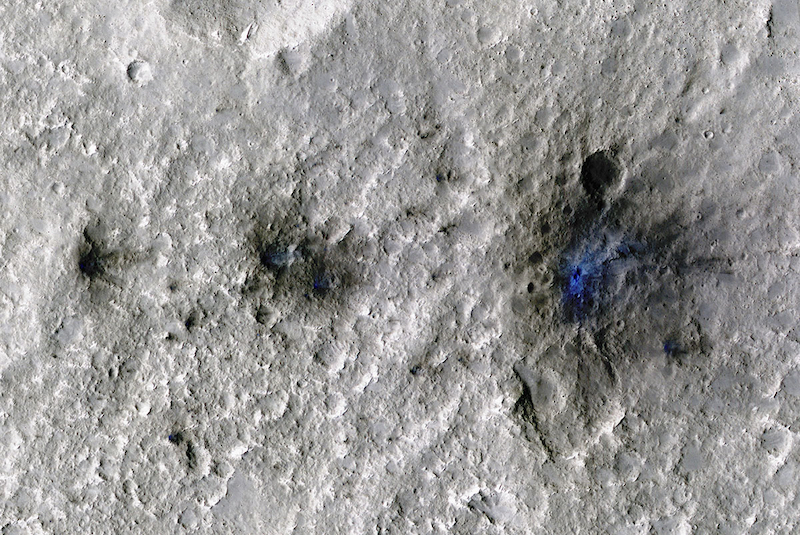
NASA’s InSight lander has been busy studying the interior of Mars since 2018. In that time, it has detected over 1,300 marsquakes – the Martian version of earthquakes – and revolutionized our understanding of the planet’s subsurface. Now, mission scientists say it has added another scientific accomplishment to its list. NASA announced on September 19, 2022, that, for the first time, InSight has heard the impacts of four meteoroids as they crashed into the Martian surface. The lander detected the vibrations from the impacts in 2020 and 2021.
The researchers published their peer-reviewed findings in Nature Geoscience on September 19, 2022.
Scientists had been hoping that InSight would detect such impacts, and now it finally has. As the paper reported:
Here we report observations of seismic and acoustic waves from the NASA InSight lander’s seismometer that we link to four meteoroid impact events on Mars observed in spacecraft imagery. We analysed arrival times and polarization of seismic and acoustic waves to estimate impact locations, which were subsequently confirmed by orbital imaging of the associated craters.
You can listen to the sounds InSight captured below:
InSight hears meteoroid impacts on Mars for 1st time
This is the first time that InSight – or any Mars lander or rover – has ever detected the seismic waves from a meteoroid impact. So far, InSight has “heard” the impacts of four different space rocks. Scientists call these rocks meteoroids before they hit the ground. Afterward, as on Earth, the fragments are called meteorites.
The four impacts occurred between 53 and 180 miles (85 and 290 km) from InSight’s location in Elysium Planitia. The first one broke into three parts and created three new craters on the surface on September 5, 2021. Scientists then later confirmed impacts from three other meteoroids: on May 27, 2020, and on February 18 and August 31, 2021.
NASA’s Mars Reconnaissance Orbiter took images of the impact sites from orbit. They appeared as dark spots in the orbiter’s black-and-white Context Camera. Later, the High-Resolution Imaging Science Experiment camera (HiRISE) took detailed color photos. The three-year wait for InSight to finally detect a meteoroid impact was well worth it. Co-author Ingrid Daubar of Brown University said:
After three years of InSight waiting to detect an impact, those craters looked beautiful.
The seismic waves generated by the impacts can give scientists clues about both the impacting rocks and the Martian subsurface. The impacts produced small marsquakes, up to a magnitude of 2.0. By comparison, the largest tectonic marsquake detected so far was magnitude 5.0. Seismic waves, however they are produced, can provide clues about Mars’ crust, mantle and core.
The clocks of the solar system
In addition, such impacts can teach us about Mars’ geological history. Lead author Raphaël Garcia of the Higher Institute of Aeronautics and Space in Toulouse, France, stated:
Impacts are the clocks of the solar system. We need to know the impact rate today to estimate the age of different surfaces.
As on any rocky planet or moon, scientists can use impact craters to determine the age of the surface. Basically, it’s fairly simple: the more craters there are, the older the surface is. Then, researchers can compare the rate of impacts in the past to the rate of impacts today.
Trajectory and shock waves
Not only do impacts reveal clues about the planet but also about the impact events themselves. By using both InSight’s data and orbital images of the impact craters, researchers can determine the meteoroid’s trajectory and size of its shock wave (seismic wave). Even though Mars’ atmosphere is extremely thin, the meteoroids create shock waves as they hit it and explosions when they hit the ground. Garcia said:
We’re learning more about the impact process itself. We can match different sizes of craters to specific seismic and acoustic waves now.

Unfortunately, InSight’s mission is likely coming to an end soon. InSight uses solar panels for power, and accumulating dust means that it will run out of power by the end of this year or early next year.
Bottom line: NASA’s InSight lander has heard meteoroid impacts on Mars for the 1st time, scientists say. The four impacts provide clues not only about the space rocks, but about Mars’ interior as well.
Source: Newly formed craters on Mars located using seismic and acoustic wave data from InSight











